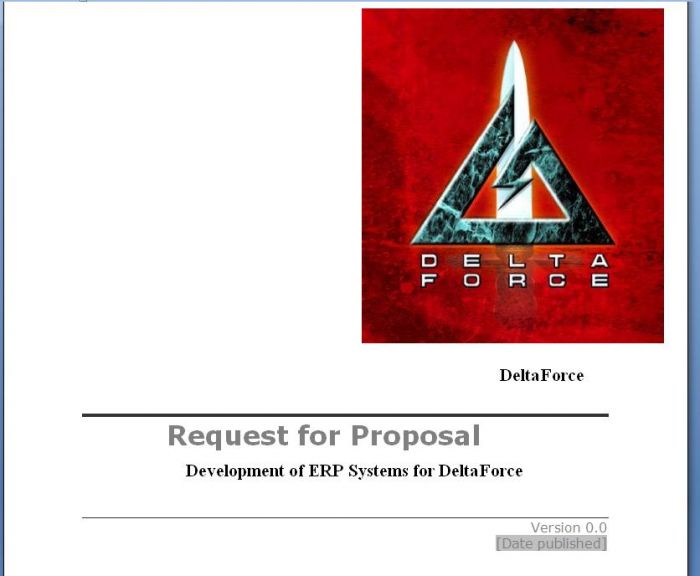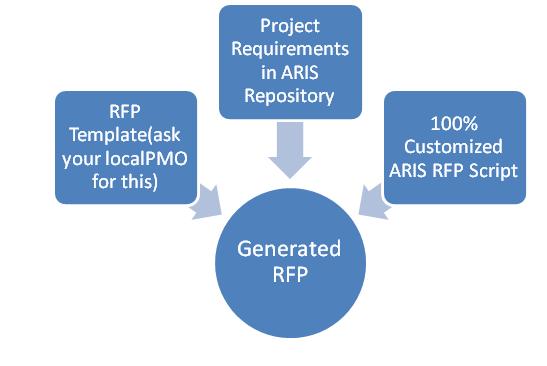Out-of-box ARIS BA does not provide any generation of so called "Deliverables" (in PMO linguistic). PMO (Project Management Office) guys are interested in Deliverables, Milestones, so that they can keep track of Gates/Phases and feed their hungry Project Servers. Trust me, these guys are not at all interested in fancy looking (but good for nothing) EPC/Value Added Chain diagram.
You want to utilize ARIS for RFP generation then this article is for you.
Properly customized ARIS, is widely utilized(do not ask me for statistics how many companied are using, what capacity. but rumour has it a lot of companies are using ARIS for this purpose) to generate these deliverables such as RFP/SOW/PEP etc. I am not gonna lie to you, you need 100% customized ARIS reporting script to carry out this task + optional external app code (i will explain why you need this) to accomplish this simple task of auto RFP generation.
What is an RFP?
To Simply State, RFP document is a set of requirements which has to be satisfied by Vendor's solution (i.e Vendor Proposal). RFP also contains some information about your company + legal issues + some PMO stuff + legal requirement to be fulfilled by Vendor i.e. Vendor must have valid registration, vendor must not sub-contract the project etc.....
Why use RFP????Confusing haaan.. Well to understand this very well, we have to go to the beginning.
In any good company, (for business reason for any other reason), they need to initiate new projects to acquire capability or to solve problem or to meet business demand etc. Requirements are gathered and refined (after brainstorming) and then RFP document is generated and published so as to invite Vendors for proposals submission, some time RFI is published (when RFP team is not sure or wanna acquire more information about the product). These steps totally varies from company to company but some how standardize thanks to PMP certs. Chances are your company might follow this pattern:
1. Need to Start new Project or to acquire new capability ( eg. ERP System)
2. RFP team is formed to gather requirement and generate RFP.
3. RFP or RFI published
4. Vendor respond by providing Solution Proposal
5. RFP team then Evaluate the technical Proposal
6. RFP team then shortlist the proposals and then send to Bid-Evaluation committee
7. Lowest Bid is selected (Rule of thumb) or otherwise.
8. Purchasing/Contracting Department send Purchase Order to Vendor
9. Vendor Deliver Solution
9 a. SOW (Scope of Work) is determined and agreed upon
9b PEP is generated
10..
11...
12... Project is closed (Lesson learned etc...)
You may have noticed the above steps are not organized so PMO organized this by grouping them into phases. (Yeah I know, you can use BPM to document the process step but this article is not about RFP Process but rather how to generated RFP document)
Anyways, we are interested in generating RFP from ARIS. How to do this? You need to make sure RFP team utilizes ARIS tools for high level requriment documentation. Train them and ask them to create Projects (Tasks) in ARIS and associated each Projects with Requirements (Requirements can be of many types, functional, non-functional, technical etc, more on this later). You are definitely need to develop custom filters and call it RFP_TEAM_Filter which will only allow them to access Task Diagram, Requirement Tree,Matrix Diagram etc.
SAMPLE RFP:You can inspect a sample RFP document here
From simple inspection, RFP document consists of two type of contents:
1. Static/Fixed Content (Content which will be same for all the RFP i.e ERP RFP, CRM RFP, GIS RFP etc.)
2. Dynamic Content (Which will depend upon each project requirement).
The idea here is to utilize ARIS to store dynamic content (mainly Project Requirements) and utilized Reporting Mechanism to automatically extract Dynamic Content based upon project and insert them into RFP Template(RFP template is nothing but static content with dynamic part removed). We will explore this more ....



